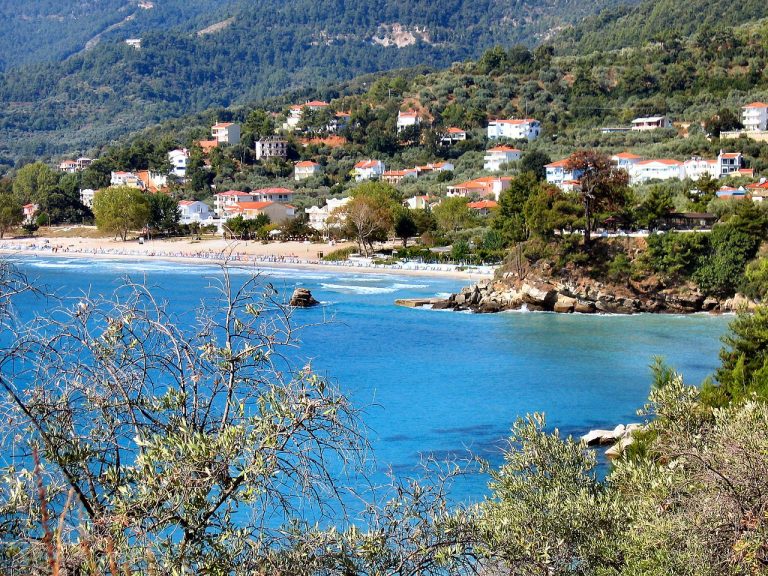Many of the old customs of Chalkidiki are fortunately still observed to this day. Of these, a good number have been brought by the uprooted Greeks from the Propontis, from Smyrna, and other places in Asia Minor.
At Galatista, on January 6th and 7th, the custom of the “camel and the bride” is reenacted. It has its roots in the years of Ottoman rule and represents the real event of the abduction of a young Greek girl by a Turkish aga and the efforts of the girl’s fiance to find her and take her back with the help of his fellow villagers, and many her.
Carnival is celebrated in many parts of Chalkidiki – such as at Polygyros, at Aghios Mamas, at Aphytos, Nikiti, Polychrono. Stra-toni, Arnaea and Flogita. A custom known as “kakts’amaka”, that is “stay and eat for free” is celebrated at Polygyros, on the last Sunday of Carnival. During the festivities, the inhabitants offer sausages, pittas, olives, etc., to all.
The eating and drinking are accompanied by music and dancing, joking and teasing, and there is also a procession of carnival floats and masqueraders. At Arnaea and Nikiti. besides the events of the last Sunday of Carnival, a fete takes place on “Clean Monday”, the first Monday of Lent. On March the first, the folk custom of the “Swallow” takes place, celebrating the coming of spring. On the eve of the day, school children decorate wooden swallows with fresh greenery. On the day itself the children, holding the decorated “swallows”, go from house to house, singing a song which speaks of the swallows coming from Arabia and bringing spring and summer.
At Arnaea, on the Tuesday after Easter, was celebrated a custom known as the “Kotzamanis” which also had its roots in the time of Ottoman rule. After the service in the little church of St. Paraskevi, the men used to practice shooting, using as their target a red egg hung from the highest tree. The contest was accompanied by feasting, singing, and dancing.
At Ierissos, on Easter Tuesday, is celebrated a custom known as “Tou Mavrou niou t’ aloni”, ( the ill-fated youth’s threshing floor” ), which takes place at a site known by the same name, in the hills two kilometers southeast of the village. After the church service, the older inhabitants of Ierissos begin the dance, and gradually everyone joins in singing and dancing all the Easter songs, ending with the “kangeleftos”, a dance reenacting the slaughter of 400 inhabitants of Ierissos by the Turks, at the time of 1821., uprising.
The line of dancers passes under an archway of laurel branches held by two young men with raised swords. In the middle of the song, the line folds into two with the dancers of the one side passing by their partners opposite for the last farewell. During the fete, a cup of coffee known as the “grafitikos”, which has been boiled in a large cauldron, Easter bread known as “tsourekia” and red eggs, are handed around. The dance is repeated in the afternoon in the main square of the village. On July 26., on the occasion of the fete of St. Paraskevi, at Arnaea, at the little church dedicated to the saint, the “kourbani” of St. Paraskevi takes place, in which food is cooked and shared with all those present.
A celebration on the feast day of St. Paraskevi ( 26. July ) also takes place in other villages of Chalkidiki, such as Aghios Nikolaos, Aghia Paraskevi, Galatista, Kryopghi, and Nea Triglia. A “kourbania” also takes place in Ierissos on the 20th July, during the fete of the Prophet Elijah, with food offered to locals and visitors alike. On the 15th of July, the feast day of the Dormition of the Virgin, there are fetes at the village of Megali Panaghia, at Aphytos, at Kryopighi, at Nea Triglia, and at Kalandra with dancing in the village square.
The fete of St. Panteleimon on the 27th of July, which is celebrated at Kallithea, is accompanied by cultural events. On the same day are held fetes at the little church of St. Panteleimon, 6 kilometers west of Nikiti, and Parthenionas.
In July, at Arnaea there is an exhibition of woven goods and other folk handicrafts.
In July is held the Sardine Festival at Nea Moudania and Nea Rhoda.
On a Sunday, before last in July the “crossing of the Toronean Gulf”, attracts swimmers, who swim from Kallithea across to the beach of Nikiti, without the use of flippers or any other auxiliary means.
In September, the community of Neos Marmaras organizes a “tuna fishing” event.
On September first, in the little church of St. Mamas, four kilometers outside the village of Aghios Mamas, is held a big county fair, while on the 8th of the same month is celebrated the feast day of the Virgin Koryfini, whose icon was brought to Aghios Mamas by refugees from the Propontis.
On November 14th, various events are organized at Nea Potidaea to commemorate the anniversary of the Holocaust of Cassandra. On December 26th, in the square of Ierissos is cooked a suckling pig which is shared out amongst all, together with plentiful amounts of wine.
USEFUL TELEPHONE NUMBERS
Thessaloniki (2310)
Police …………………………………………………….. 416787
Tourist Police ………………………….. 554871, 544162
OTE ( National Telephone Company )
Offices ……………………………………… 271888, 222935
Municipality …………………………………………. 273744
First Aid ( EKAB ) ………………………………………. 166
On-duty chemists ……………………………………… 107
On-duty hospital ………………………………………. 108
Polygyros (23710)
Police ………………………………………………………….. 23333
Tourist Police …………………………………………….. 23496
Town Hall 2 ………………………………………………….. 2313
OTE ( National Telephone Company )……… 22699
Hospital ……………………………………………………… 24021
In Chalkidiki, besides the hospital in Polygyros, health centers are providing first aid at Nea Kallikrateia, at Cassandreia, at Aghios Nikolaos, and Palaiochori.
